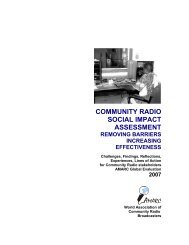Live News - A Survival Guide - International Federation of Journalists
Live News - A Survival Guide - International Federation of Journalists
Live News - A Survival Guide - International Federation of Journalists
- No tags were found...
Create successful ePaper yourself
Turn your PDF publications into a flip-book with our unique Google optimized e-Paper software.
<strong>Live</strong> <strong>News</strong> — A <strong>Survival</strong> <strong>Guide</strong> for <strong>Journalists</strong>rather than undercook all meat foods. If you are preparing yourown food, thoroughly wash or disinfect any knife or choppingboard that was used to prepare meats before using it again.In areas where typhoid or other water-borne infections are common,be careful about eating quick-growing vegetables unless theyare well cooked. Lettuce may be suspect; cooked vegetables areprobably OK if they have been thoroughly boiled. Peel fruit or washit in clean water.If you are not confident about the quality <strong>of</strong> the food, thegeneral rule is:Cook, peel or chlorinate.Traumatic injuriesThe general approach to administering medical aid in a hostileenvironment is to stay calm and assess the situation before acting.Taking a few seconds will help you to focus on the most life-threateningconditions and to recall what you know and to focus on whatyou can do. Try not to worry about what you cannot do. A calmapproach will save lives, while panic can spread quickly through agroup <strong>of</strong> frightened people.1. Assess the danger to you — if someone has been shot and is lyingin the open, will you be shot if you go to them? If you are alsoinjured you cease to be any help in this emergency and becomepart <strong>of</strong> the problem.2. Assess the danger to the casualty. What is their most urgent lifethreateningcondition? Is the car they are in about to catch fire?Are they still in the open and being shot at? Assess the risks <strong>of</strong>leaving them where they are against the risks <strong>of</strong> moving them.3. Act to remove the casualty from the danger, or the danger fromthe casualty. If you can remove the danger — by putting out a fireor persuading someone to stop shooting — so much the better. Itis better not to move the casualty until you have stabilised theircondition, but you may have to choose the least worst option.4. Use your skills and knowledge to stabilise any life-threateningconditions; then get the casualty to a medical centre for treatmentas quickly as possible. What you do for the casualty willdepend on how long it will take to reach pr<strong>of</strong>essional help.Examining the casualtyWherever possible, you should wear gloves when approaching acasualty. There should be a pair in your first aid kit.Remove the danger from the casualtyor the casualty from the danger.Photo: Rob Judges“By pulling someone out you maykill him, but if you leave him therehe will almost certainly die. Theseare sometimes the choices youhave to make.”Paul Brown, Medical Director,AKE training73
















